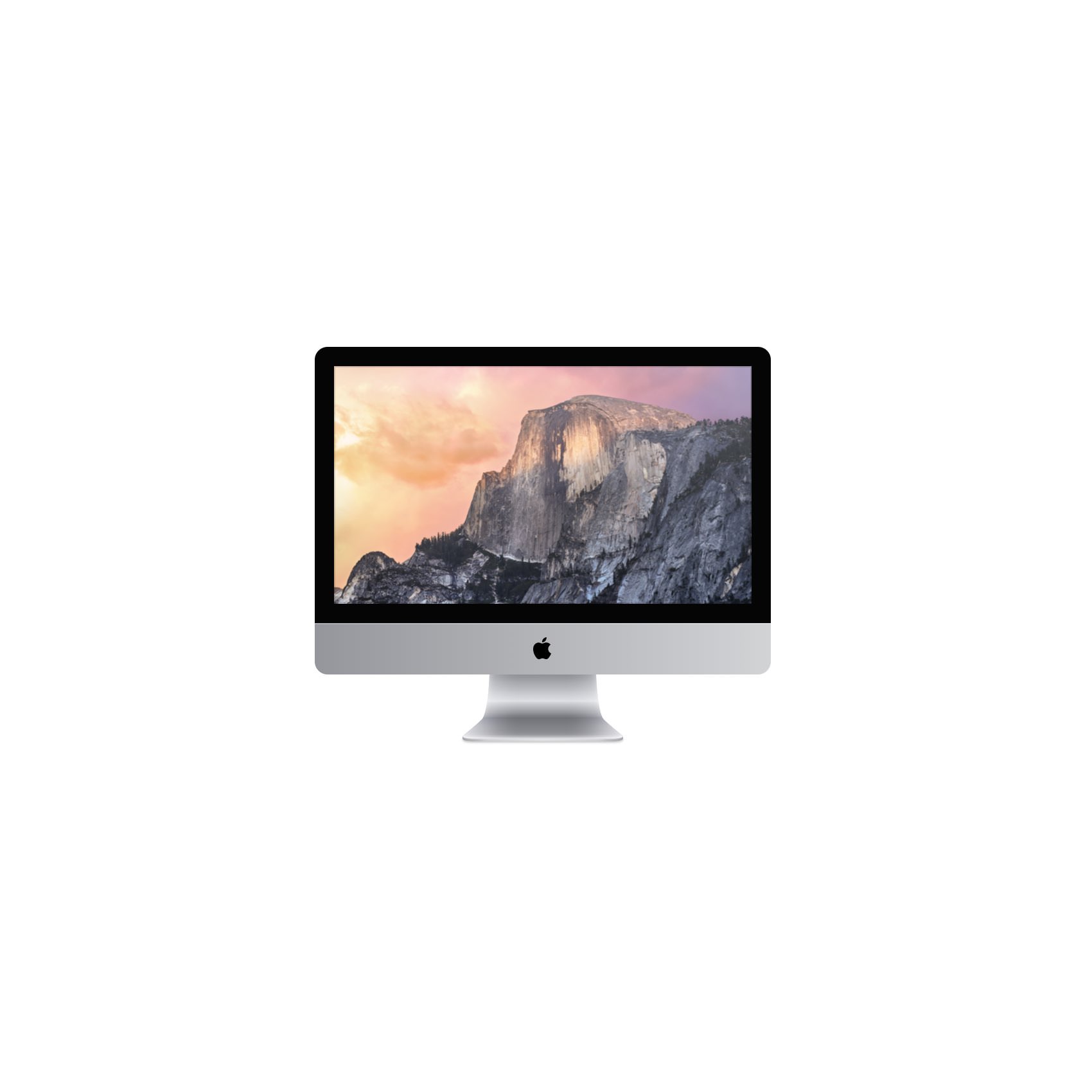Create an iMac Illustration
In the following tutorial you will learn how to create an iMac illustration in Graphic for Mac.
For starters you will learn how to set up a simple grid and how to create the main shapes using basic tools and vector shape building techniques. Using several gradients, some effects and basic blending techniques, you will learn how to add color and subtle highlights for your design.
Finally, you will learn how to add an image fill and how to turn text into editable vector shapes.
Step 1
Go to File > New (Command + N) to bring up the New Document window. Select the Grid document style, set the document units to pixels, and set the document dimensions to 600 pixels wide by 600 pixels high.
Next, we'll set up the document grid. Switch to the Grid pane in the Properties panel. If the Properties panel is not currently visible, you can easily open it using the ruler icon that lies above the Layers panel. Change the grid X Spacing and Y Spacing to 5, set the Subdivisions to 0 and enable Snap to Grid (Command + Shift + ').
Keep in mind that you can quickly enable or disable the grid and the Snap to Grid feature using the Command + ' and Command + Shift + ' keyboard shortcuts.
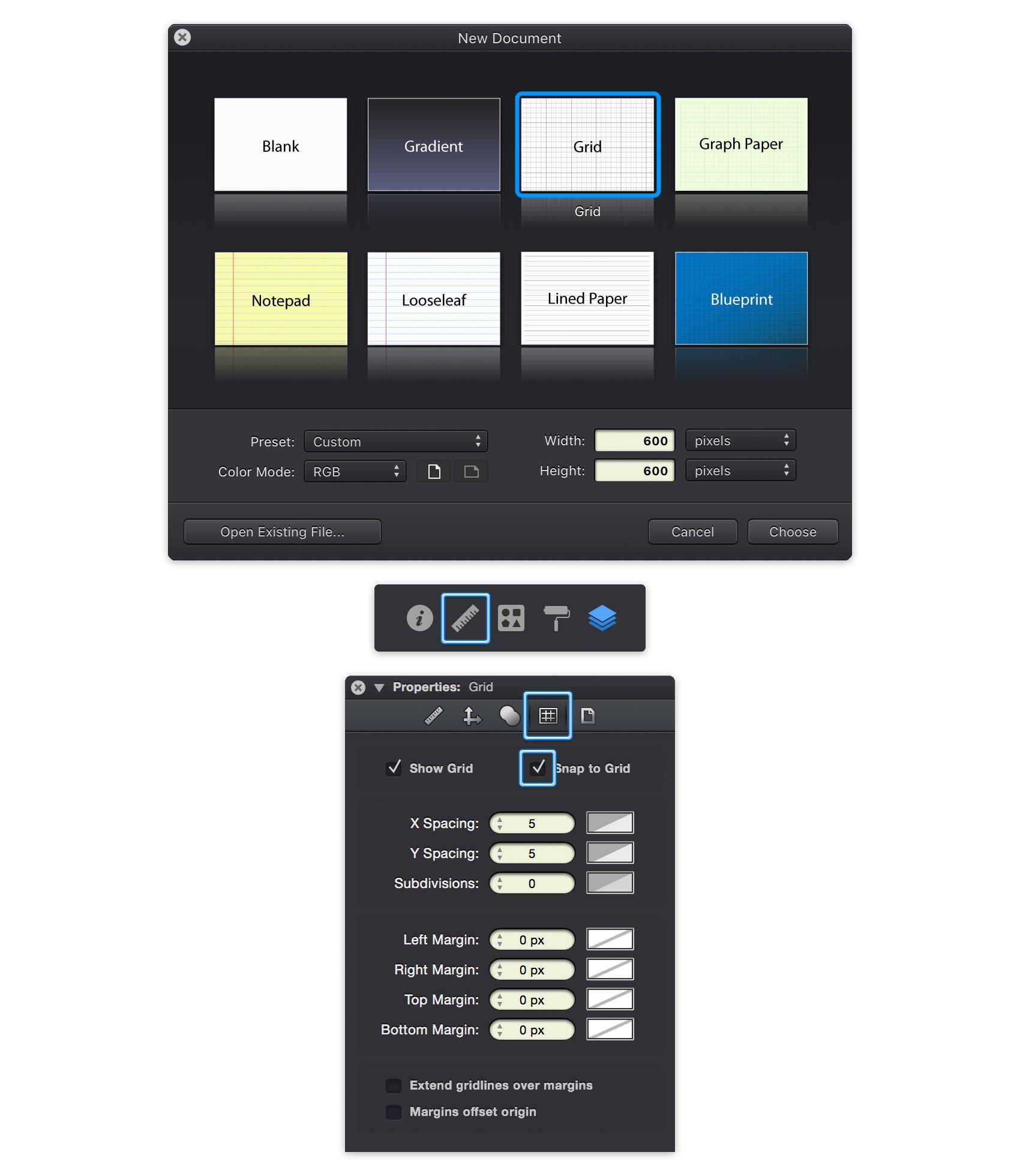
Step 2
Focus on the Toolbar and notice that by default the fill color is set to white while the stroke color is set to black. Click the Fill color well and set it to R=0 G=152 B=245 and then click the Stroke color well. Drag the Alpha slider to 0% and this will make your stroke invisible.
Pick the Rounded Rectangle Tool (Shift + M), focus on your Tool Options bar and set the Corner Radius to 10 pt. Move to your canvas and create a 355 x 255 px shape- the grid and the Snap to Grid feature will ease your work.
Make sure that this blue shape is selected and make a copy in the same place (Command + C > Command + Shift + V).
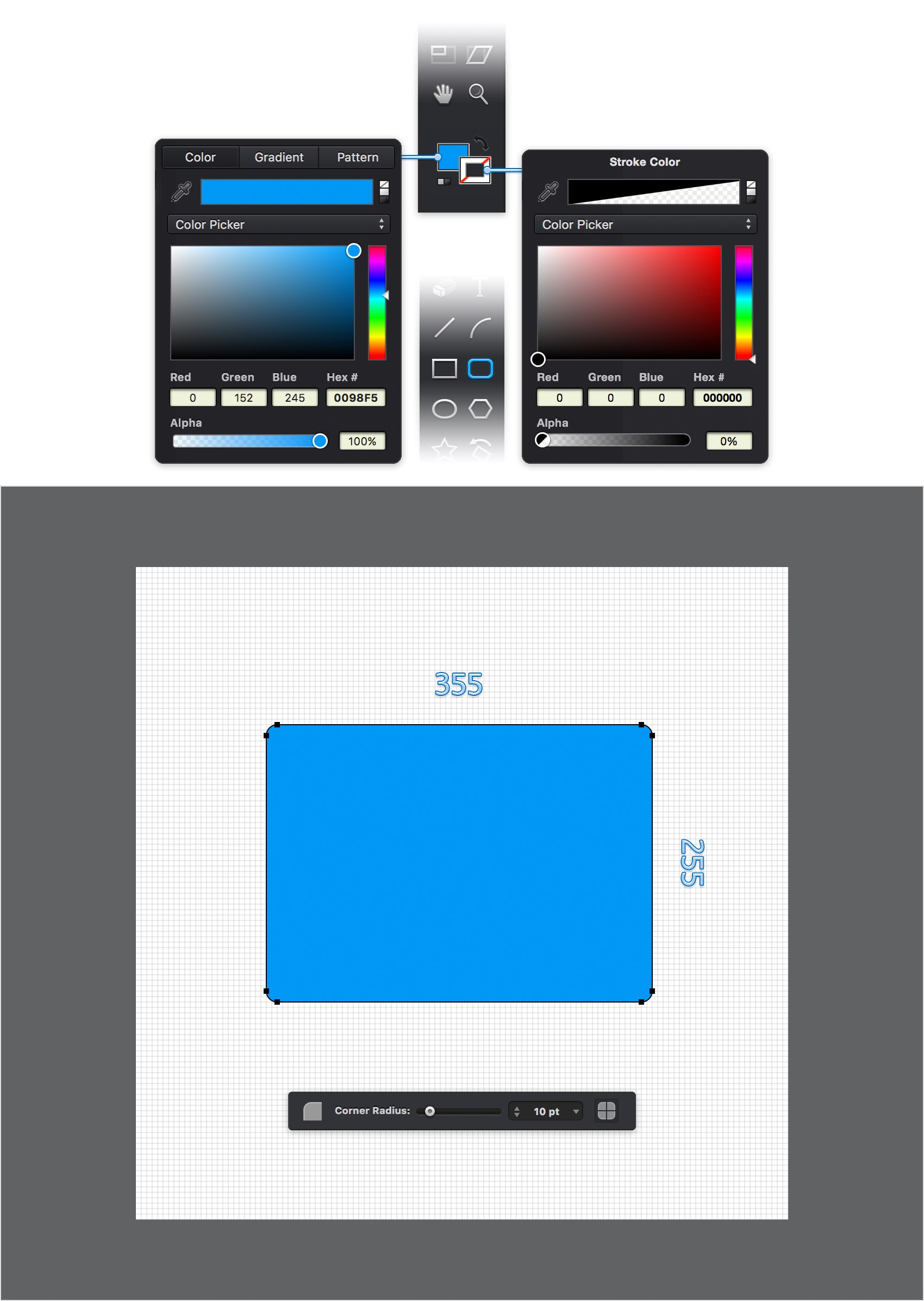
Step 3
Focus on your Toolbar and replace the existing fill color with R=255 G=185 B=2.
Pick the Rectangle Tool (M), create a 355 x 40 px shape and place it exactly as shown in the following image.

Step 4
Using the Move Tool (V), select your yellow rectangle along with the copy of that blue rounded rectangle, focus on the Path Tools pane from the Properties panel and click the Intersect button. Make sure that the resulting shape stays selected and move to the Effect pane from the Appearance panel.
Focus on the Fill and select Linear Gradient from the Type drop-down menu. Set the angle to 0 degrees and then move to the gradient sliders. Select the left one and set its color to R=148 G=150 B=152 and then select the right slider and se its color to R=210 G=211 B=213.
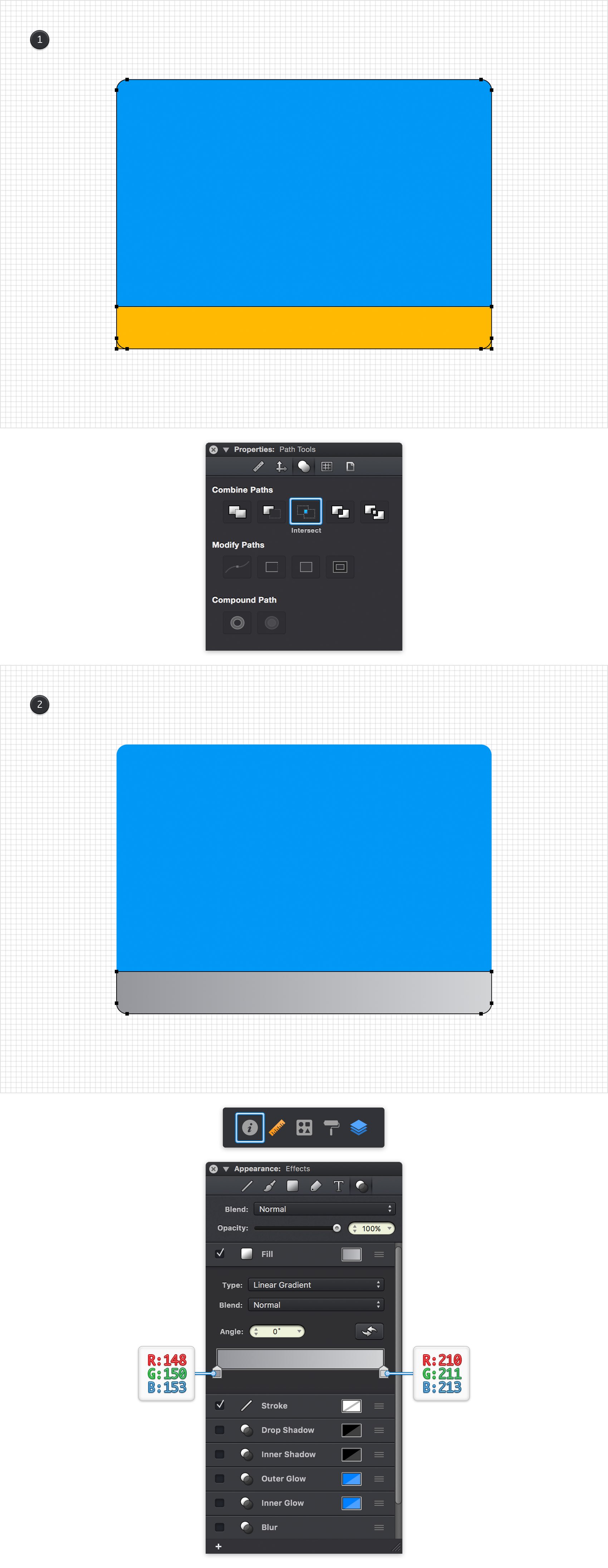
Step 5
Make sure that your gradient filled shapes stays selected, keep focusing on the Effect pane and check the box that stands for the existing Inner Shadow effect to activate it.
Enter 1 in the Y box and 0 in the other two boxes, select Soft Light from the Blend Mode drop-down menu and then click the color well that stands for your Inner Shadow. Drag the Alpha slider to 50% and set the color to white (R=255 G=255 B=255).
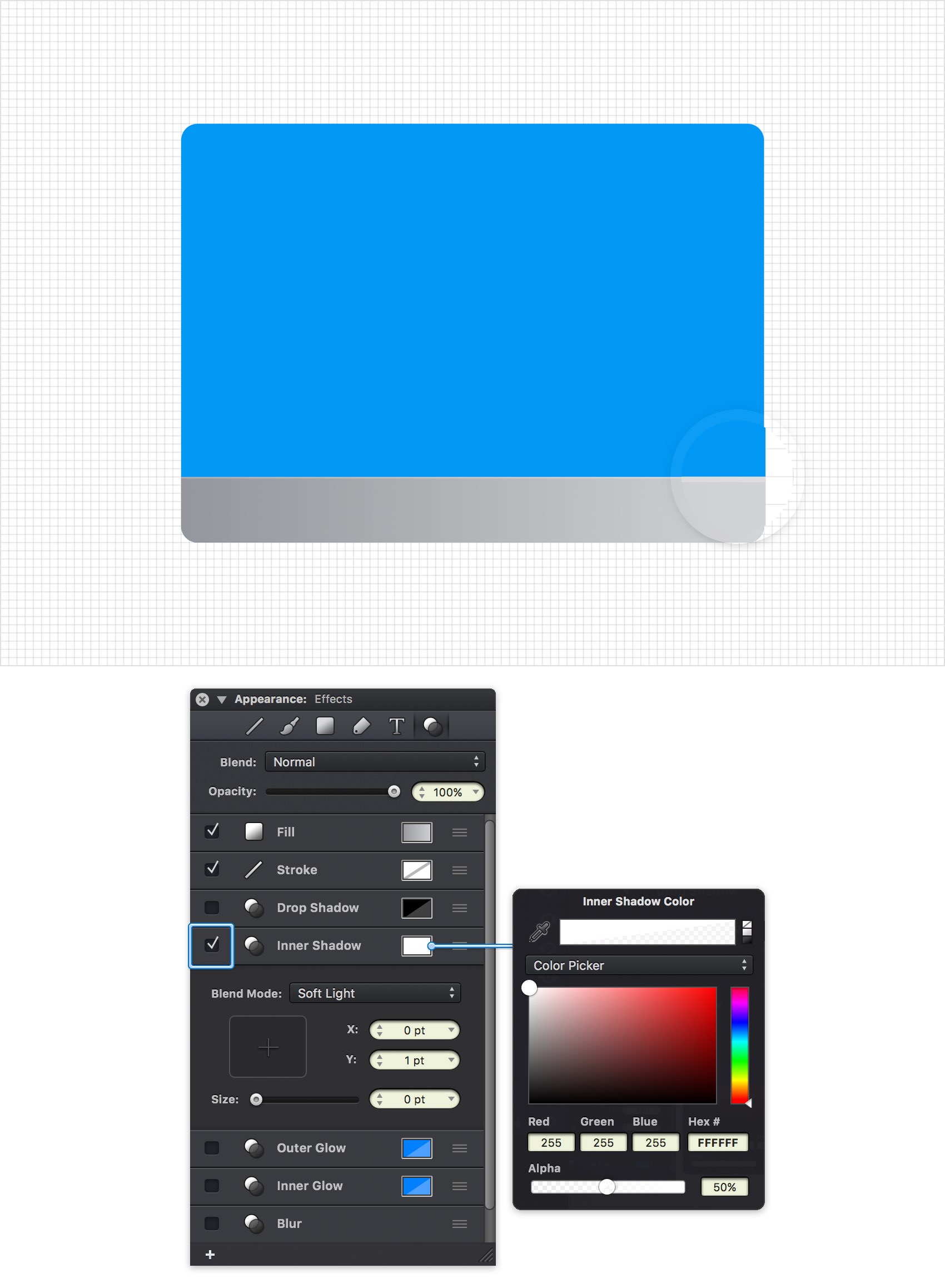
Step 6
Using the Rectangle Tool (M), create a 125 x 50 px shape, place it as shown in the following image and fill it with R=254 G=145 B=79.
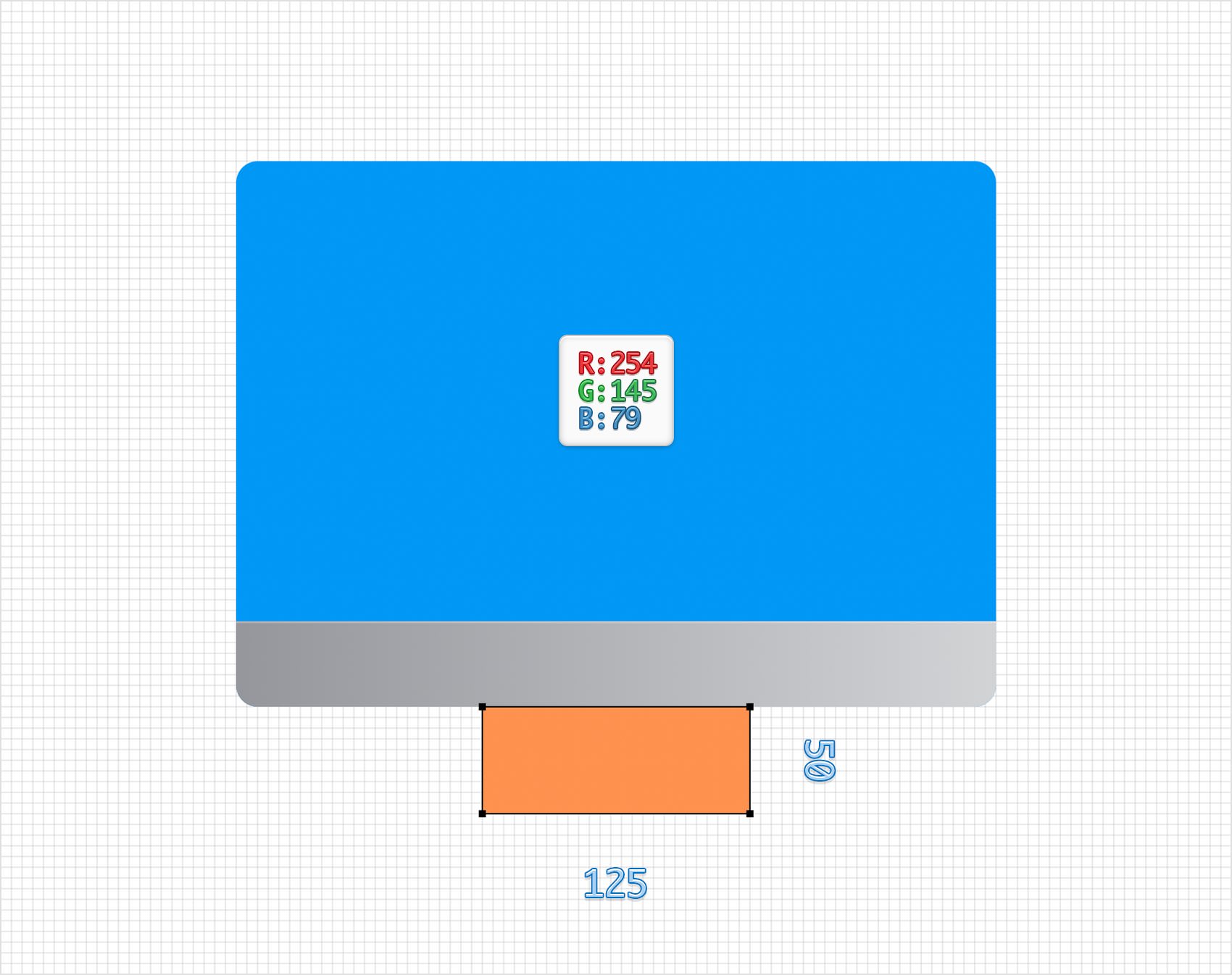
Step 7
Make sure that your orange rectangle stays selected and pick the Pen Tool (P). Focus on the Tool Options bar and activate the Add Points mode. Get back to your orange rectangle and add four new anchor points as shown in the first image.
Switch to the Path Selection Tool (A) and focus on the left side of your orange rectangle. Select the top anchor point and drag it 20 px to the right and then select the middle anchor point and drag it 15 px to the right. Move to the right side of your orange shape. Select the top anchor point and drag it 20 px to the left and then select the middle anchor point and drag it 15 px to the left. In the end your shape should look like in the third image.
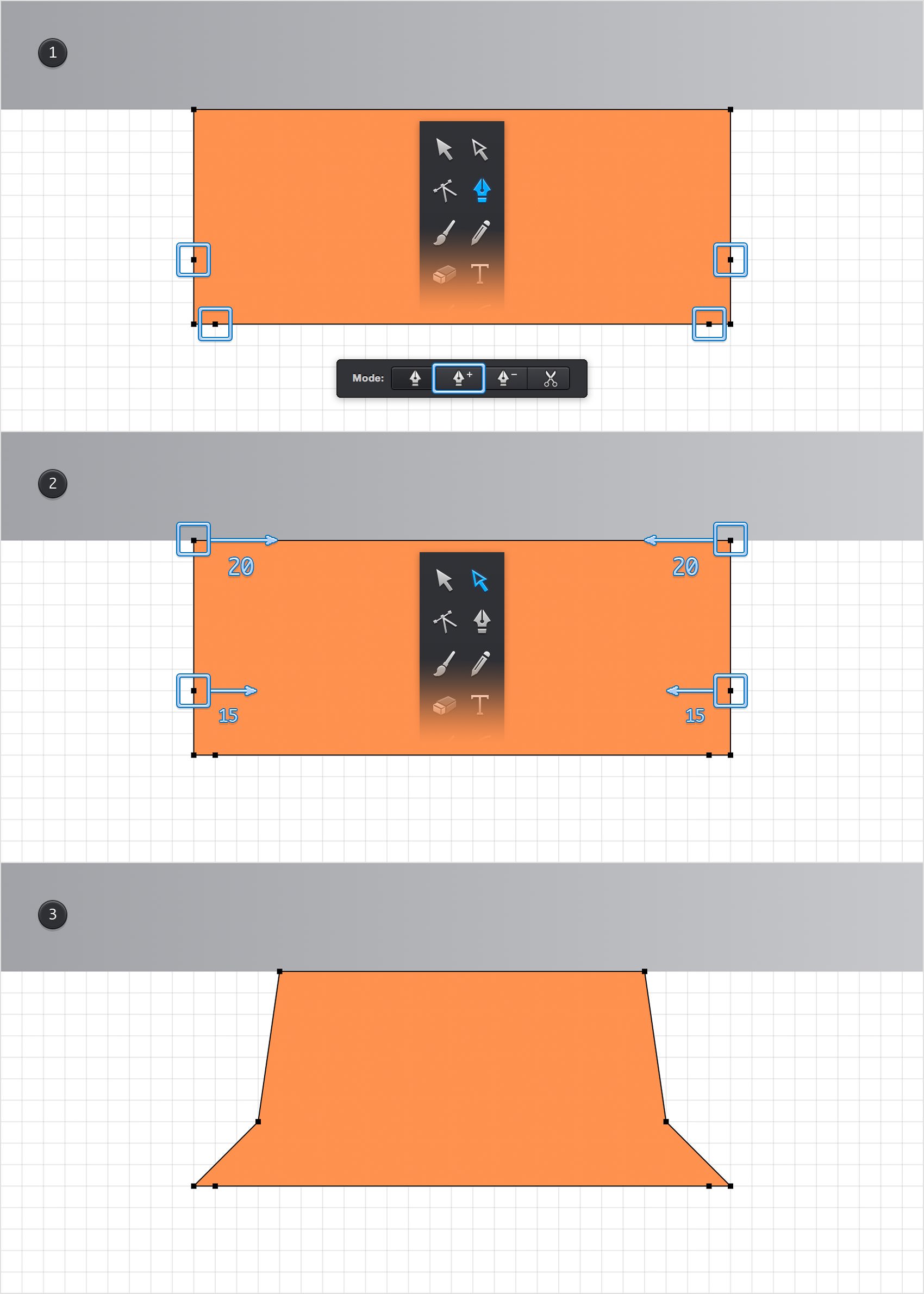
Step 8
For the following steps you will need a grid every 1 px. This means that you need to return to the Grid pane from the Properties panel and enter 1 px in both Spacing boxes.
Focus on the bottom, left corner of your orange shape and pick the Path Selection Tool (A). Select the left anchor point and drag it 2 px up and then select the right anchor point and drag it 5 px to the left. Move to the bottom, right corner of your orange shape. Select the right anchor point and drag it 2 px up and then select the left anchor point and drag it 5 px to the right. In the end things should look like in the second image.
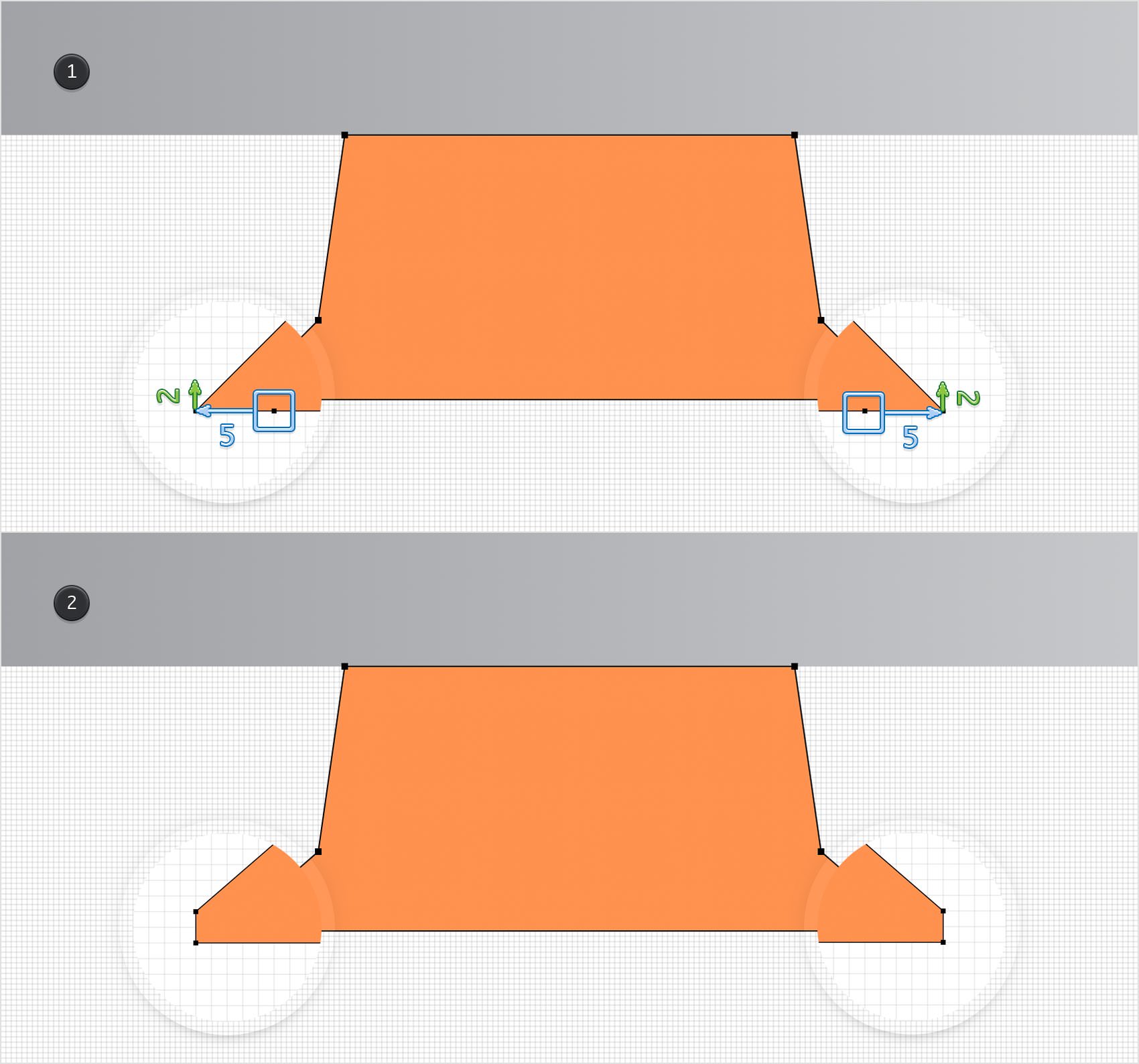
Step 9
Make sure that the Path Selection Tool (A) is still selected and focus on the top side of your orange shape. Select the left anchor point and drag it 1 px to the right and then select the right anchor point and drag it 1 px to the left. In the end things should look like in the second image.
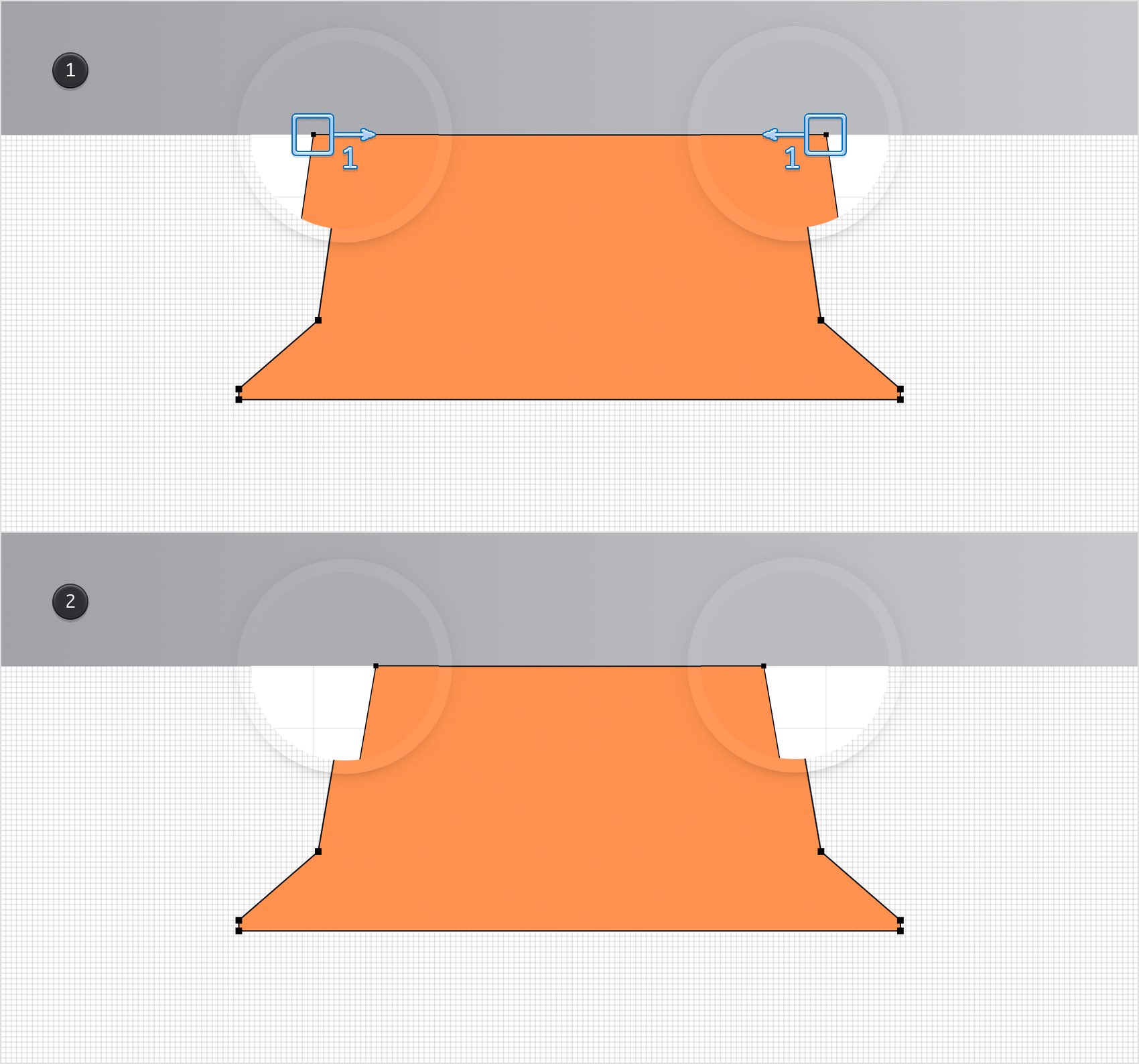
Step 10
For this step you will need a grid every 5 px. Again, return to the Grid pane from the Properties panel and enter 5 px in both Spacing boxes.
Focus on the right side of your orange shape and pick the Convert Anchor Tool (Shift + C). Simply click on the anchor point highlighted in the first image and then drag those handles exactly as shown below. Move to the left side of your orange shape, click on the anchor point highlighted in the second image and then drag those handles exactly as shown below. Once again, the grid and the Snap to Grid feature will come in handy.
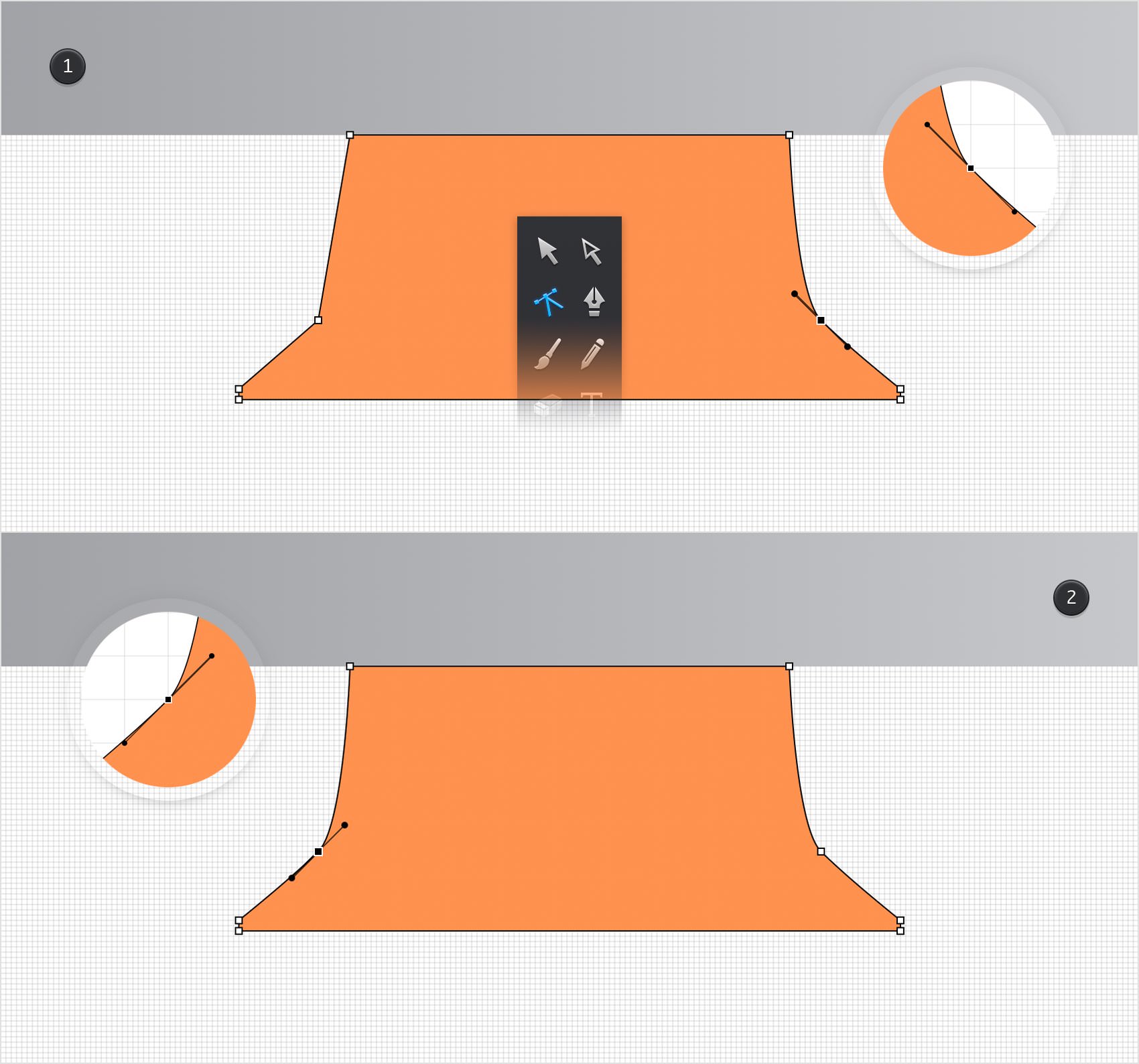
Step 11
For this step you will need a grid every 1 px. Return to the Grid pane from the Properties panel and enter 1 px in both Spacing boxes.
Focus on the bottom, left side of your orange shape and pick the Ellipse Tool (L). Create a 16 x 4 px shape, set the fill color to R=21 G=145 B=72 and place it as shown in the first image. Move to the bottom, right side of your orange shape. Create a second, 16 x 4 px shape and place it as shown in the second image. Switch to the Rectangle Tool (M), create a 109 x 4 px shape, make sure that the fill color is set to R=0 G=152 B=245 and place it as shown in the third image.

Step 12
For the rest of the steps you will need a grid every 5 px. One more time, go to the Grid pane from the Properties panel and enter 5 px in both Spacing boxes.
Reselect your orange shape along with the blue rectangle and the green circles, focus on the Path Tools pane from the Properties panel and click the Union button.
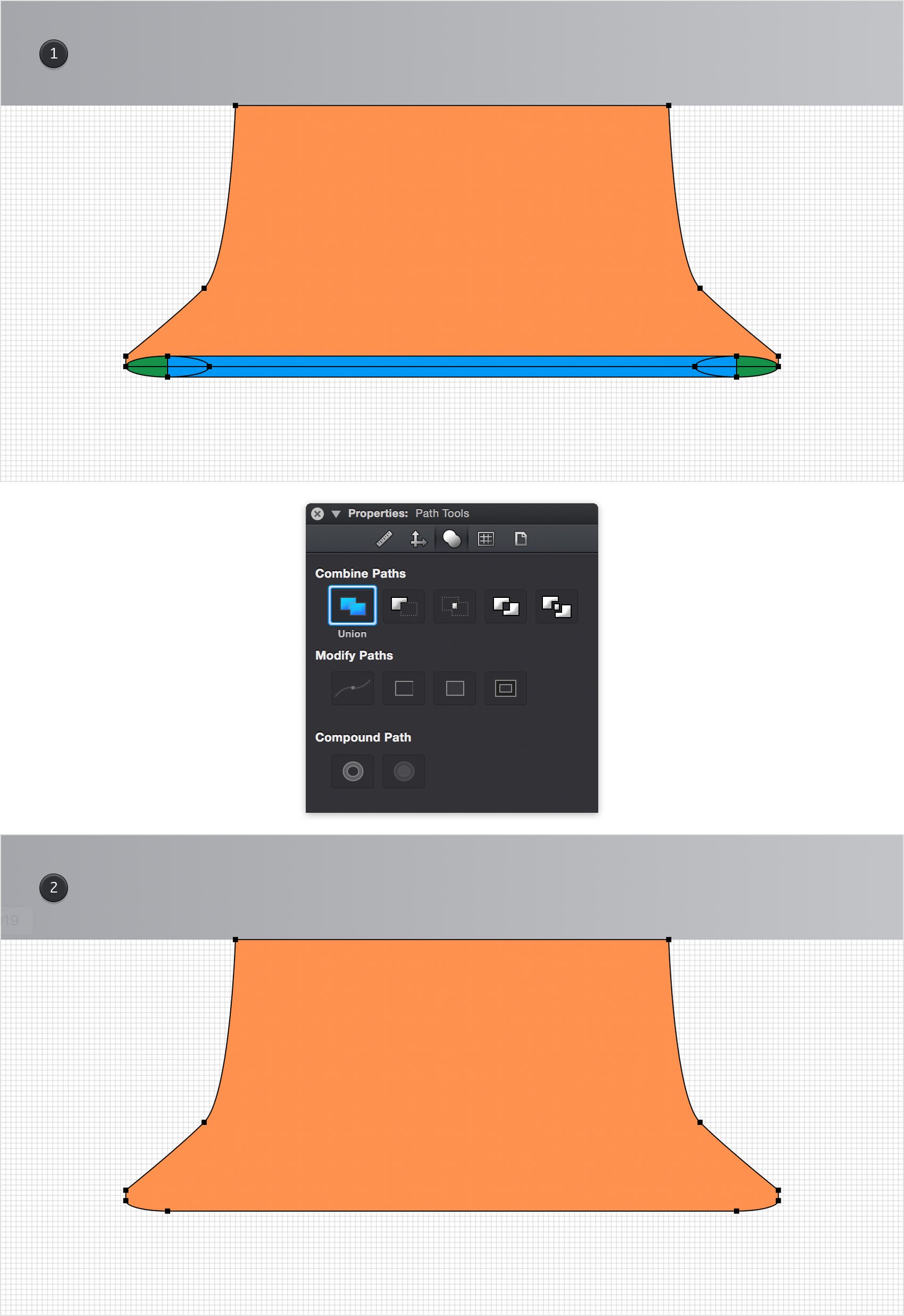
Step 13
Return to the Grid pane from the Properties panel and disable the Snap to Grid feature or use the Command + Shift + ' keyboard shortcut.
Select your orange shape and make two copies in the same place (Command + C > Shift + Command + V > Shift + Command + V). Select the top copy and hit the up arrow key twice to move your selected shape 2 px up. Reselect both copies made in this step, focus on the Path Tools pane from the Properties panel and click the Subtract button.
Make sure that your newly made shape stays selected, focus on the Effects pane and select the existing fill. Add a Linear Gradient, set the Angle at 0 degrees and then move to the gradient colors. Select the left slider and set its color to R=176 G=177 B=181 and then select the right slider and add the same color. Simply click on the gradient bar to add a new gradient slider. Select it, set the color to R=215 G=215 B=218 and drag it to the left until the Location tooltip shows 15%. Add another two sliders for this gradient and then use the color and the location attributes shown in the following image.
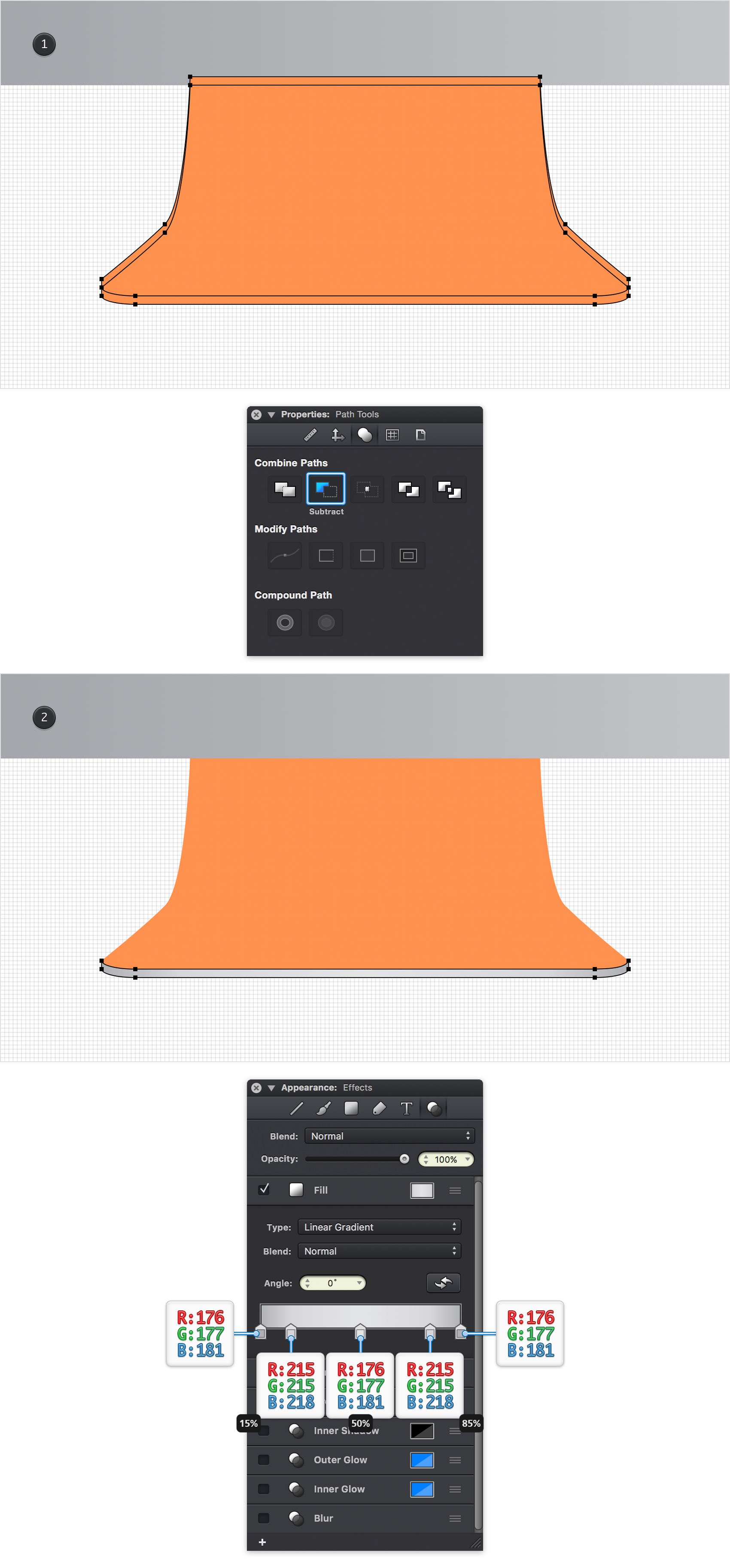
Step 14
Make sure that the shape made in the previous step is still selected and focus on the Effects pane. Activate the existing Drop Shadow effect and then enter the attributes shown in the following image.
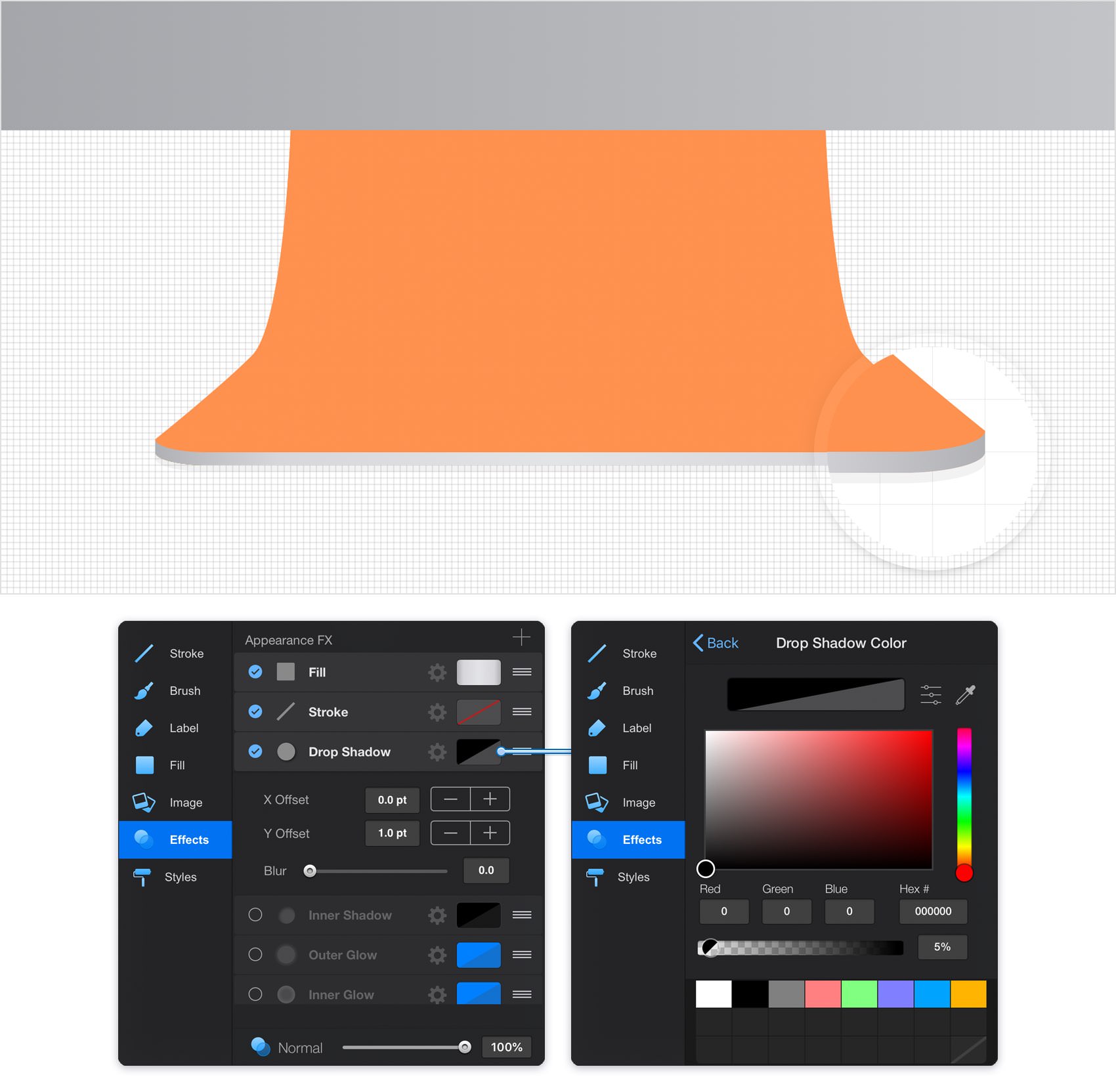
Step 15
Make sure that the shape edited in the previous step is still selected, keep focusing on the Effects pane and add a second Drop Shadow using the plus button located in the bottom, left corner of the pane. Select this new effect and enter the attributes shown in the following image.
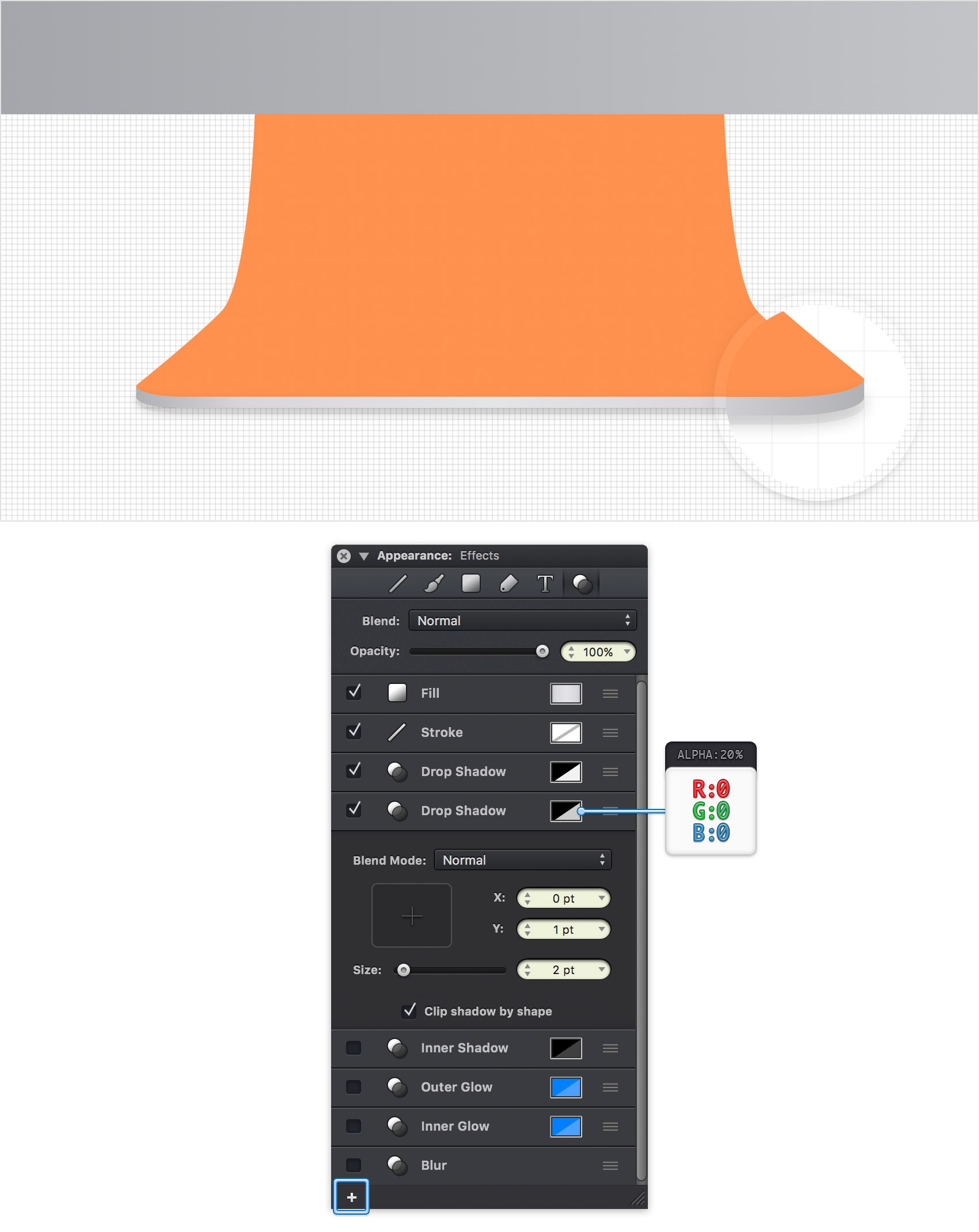
Step 16
Make sure that the shape edited in the previous step is still selected and keep focusing on the Effects pane. Activate the existing Inner Shadow effect and enter the attributes shown in the following image.
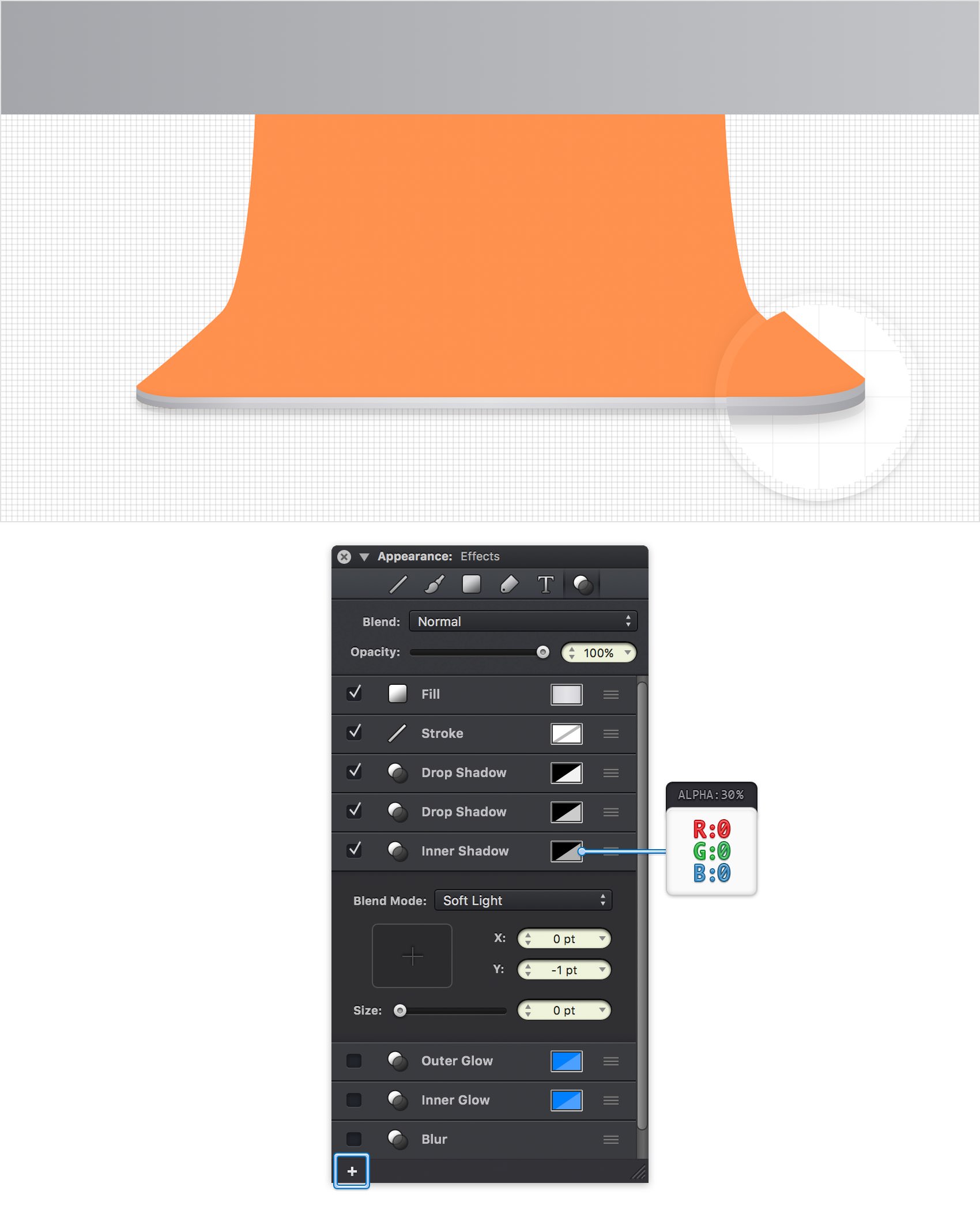
Step 17
Select your orange shape and focus on the Effects pane. Select the existing fill and replace the existing color with the linear gradient shown in the following image.
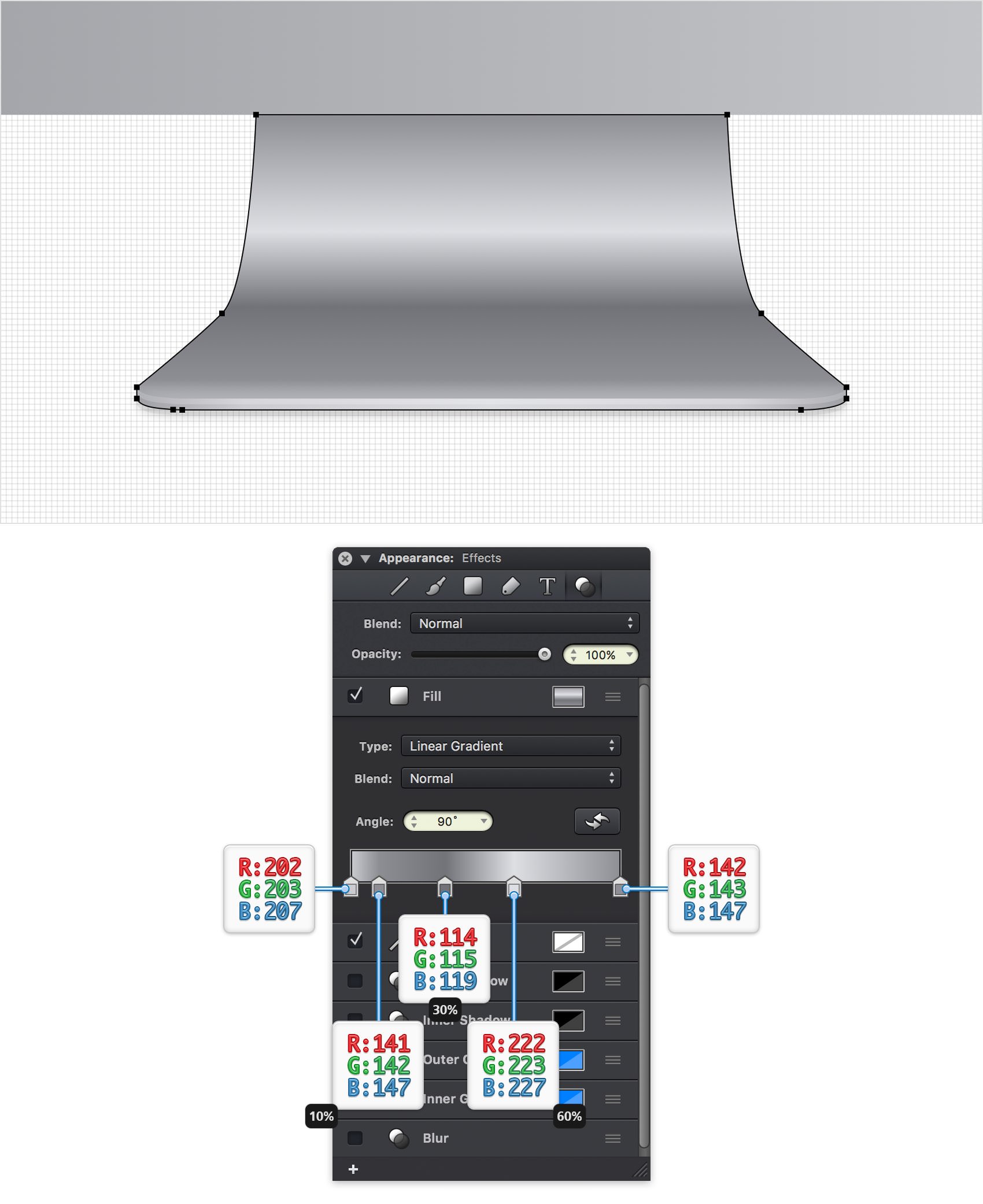
Step 18
Make sure that the shape edited in the previous step stays selected, keep focusing on the Effects pane and add a second fill using that same plus button. Select the new fill, add the linear gradient shown in the following image and don't forget to set the Blend to Overlay.
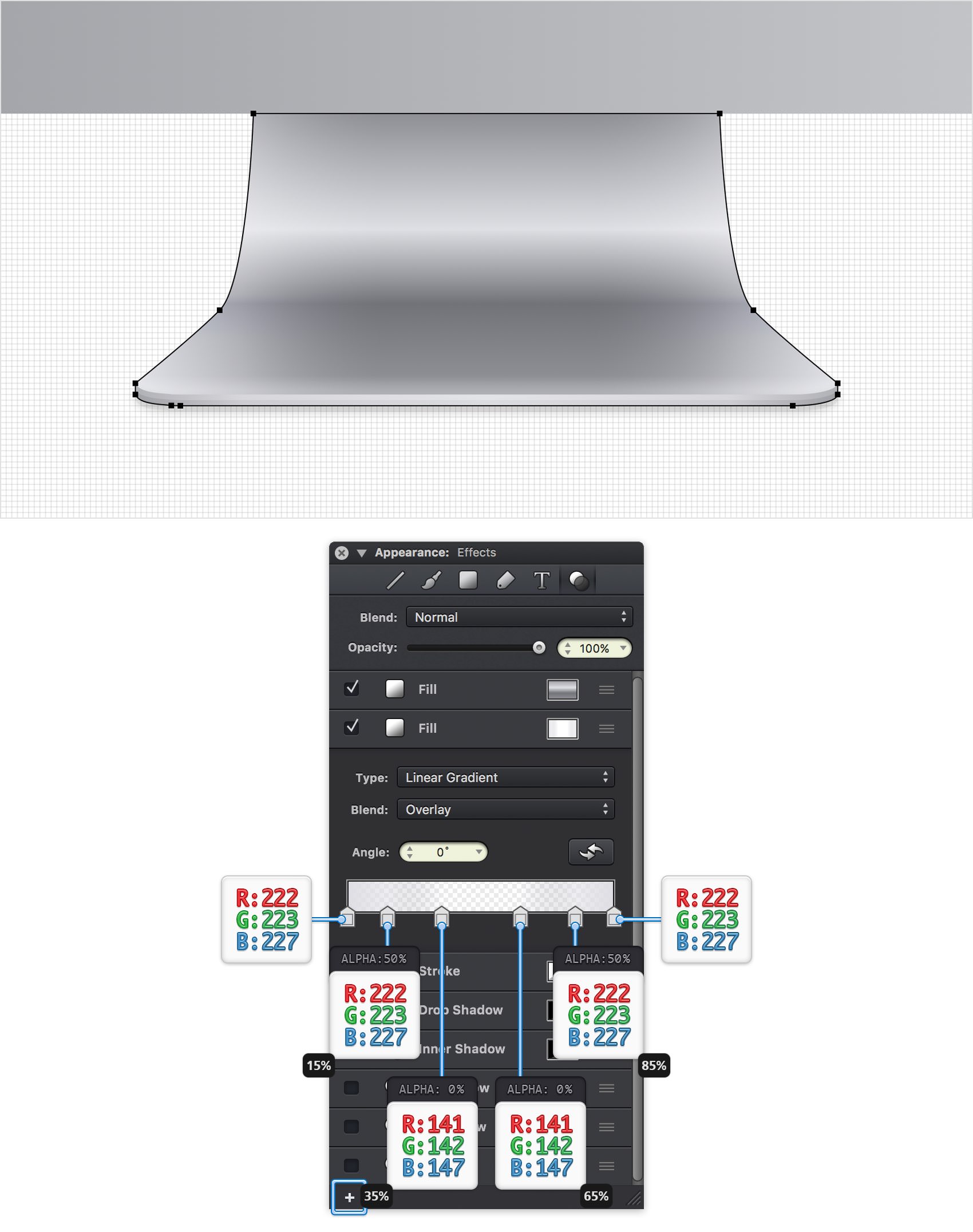
Step 19
Make sure that the shape edited in the previous step is still selected and focus on the Effects ** pane. Activate the existing Inner Shadow** effect and enter the attributes shown in the following image.
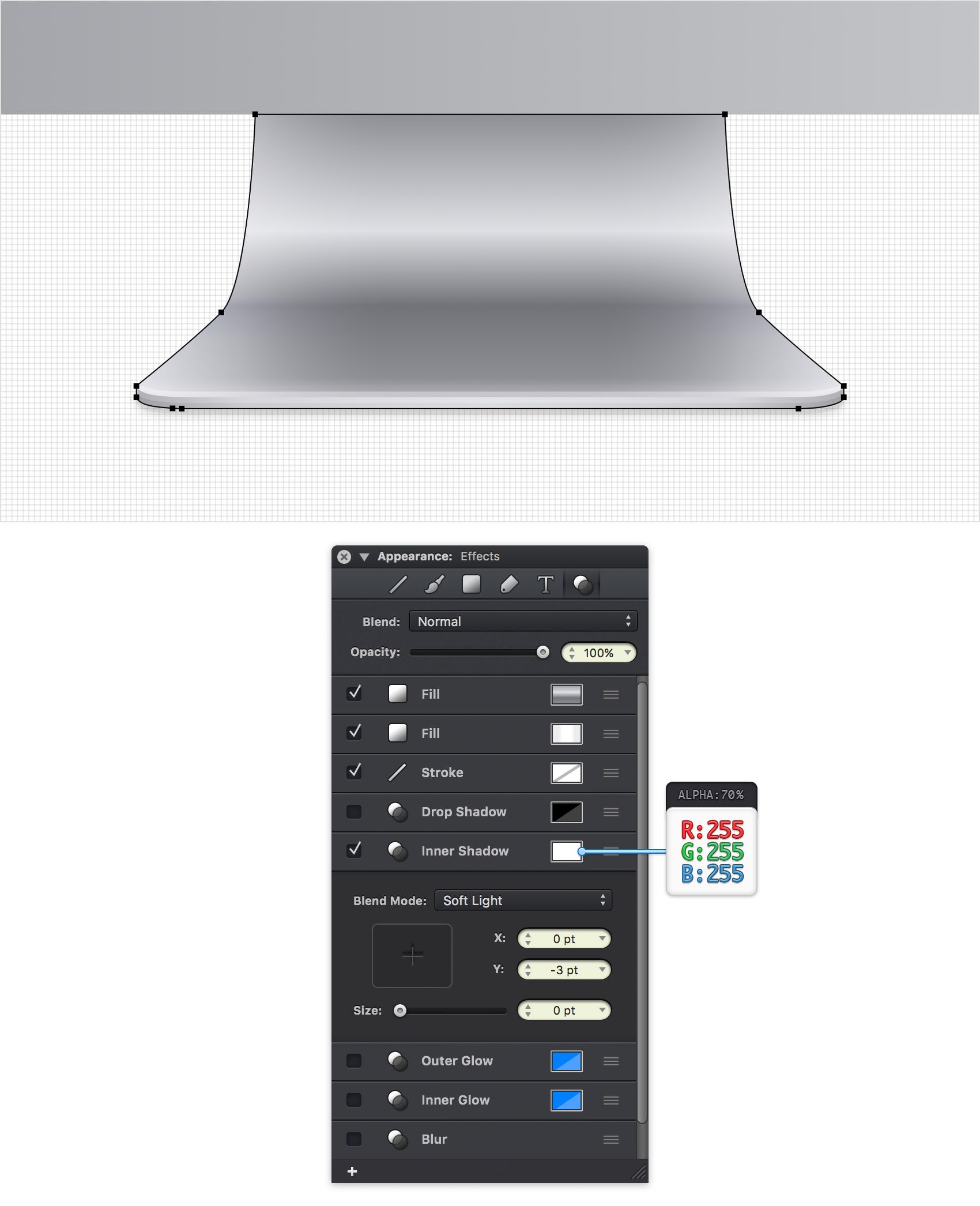
Step 20
Make sure that the shape edited in the previous step is still selected, keep focusing on the Effects pane and add a second Inner Shadow. Select this new effect and enter the attributes shown in the following image.

Step 21
Get back to the Grid and enable the Snap to Grid feature. Using the Rectangle Tool (M), create a 325 x 185 px shape and place it as shown in the following image. The fill color is not very important.
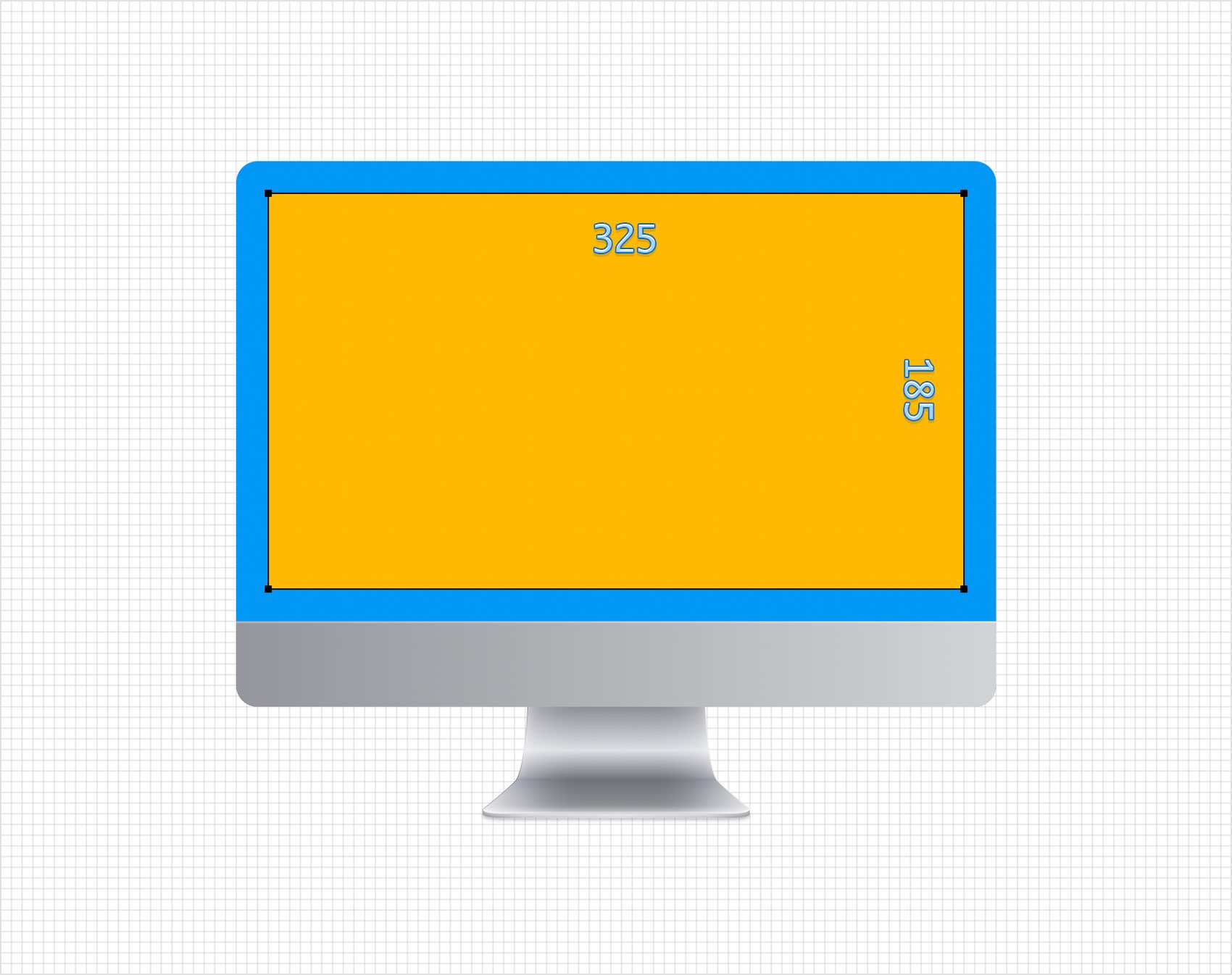
Step 22
Now, you need to download the Yosemite sunset image. Make sure that the rectangle made in the previous step is still selected and focus on the Effects pane. Select the existing fill, select Image from the Type drop-down menu and add the image downloaded a few moments ago.

Step 23
Taking a closer look at the corners of your image you will notice that it doesn't cover the entire rectangle where it lies. This little issue can be solved pretty fast. Make sure that your rectangles is selected and focus on the Effects pane. Select the existing Fill and drag the Scale slider to around 102%.
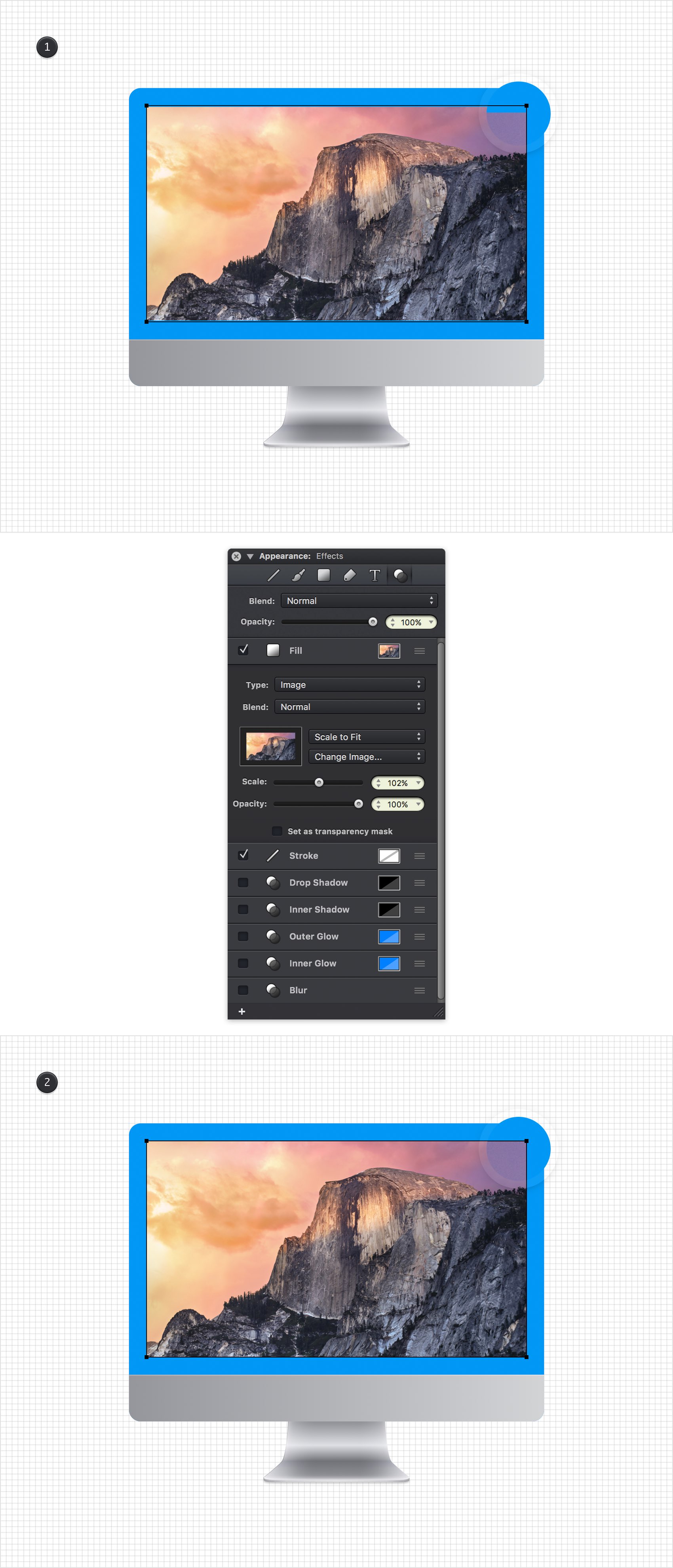
Step 24
Make sure that your image filled rectangle stay selected, focus on the Effects pane and add a second Fill. Select it and add the linear gradient shown in the following image.
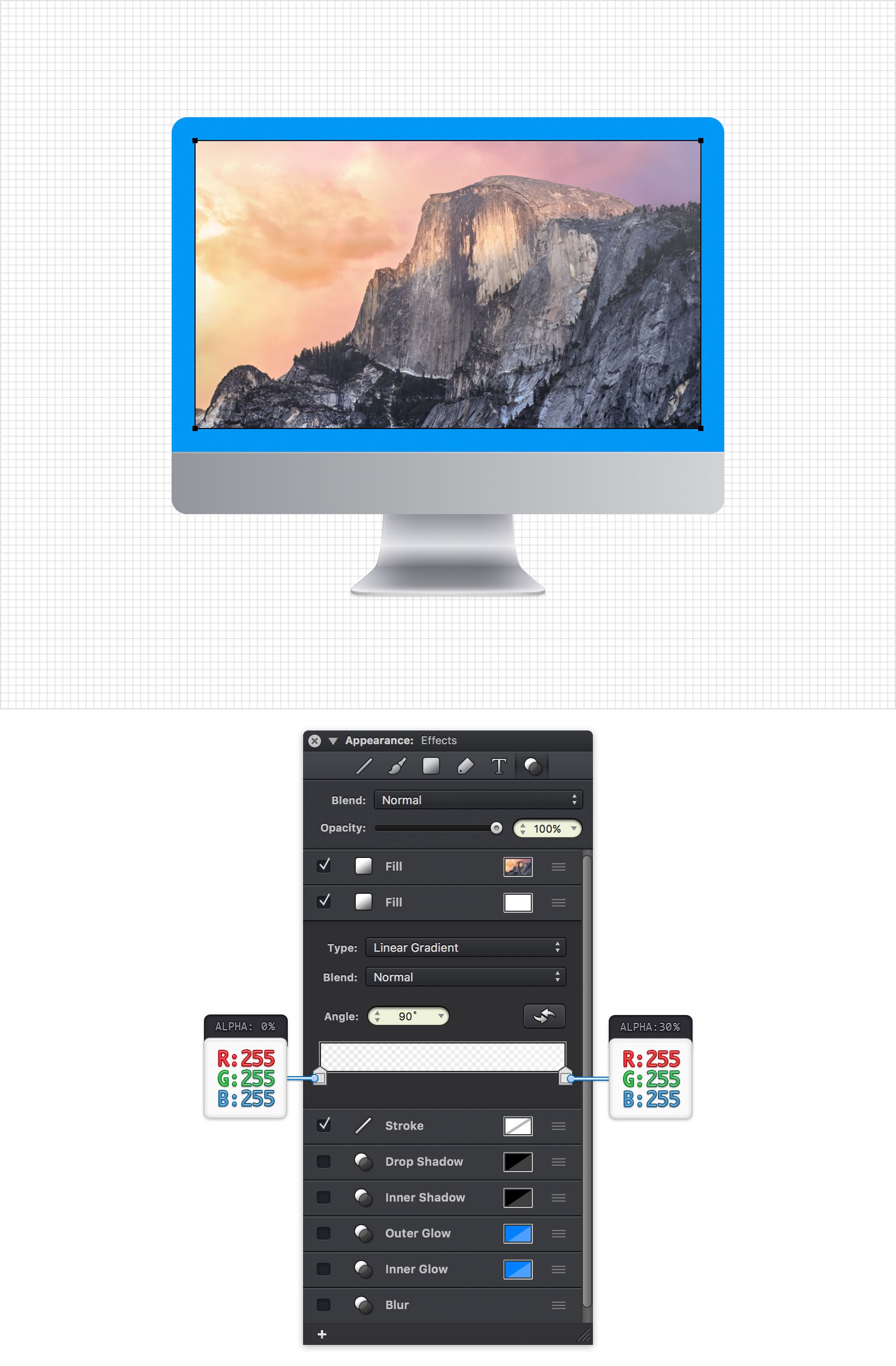
Step 25
Make sure that your image filled rectangle is still selected, focus on the Effects pane and activate the existing Stroke. Select it, drag the Width slider to 1 pt, select Inside from the Position drop-down menu and then click the color well. Set the color to black (R=0 G=0 B=0) and drag the Alpha slider to 15%.
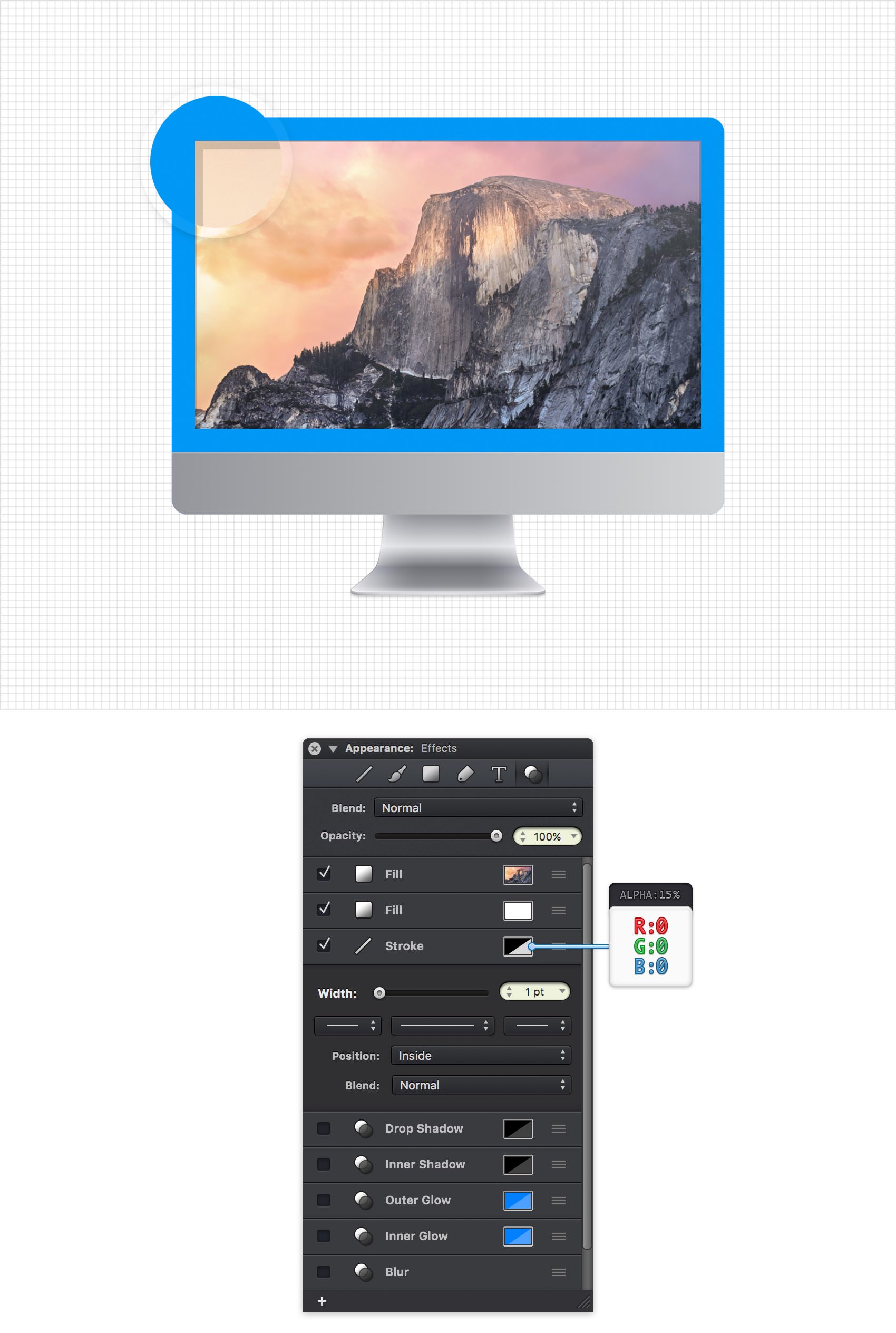
Step 26
Reselect your blue shape, focus on the Effects pane and replace the existing fill color with R=5 G=5 B=5.
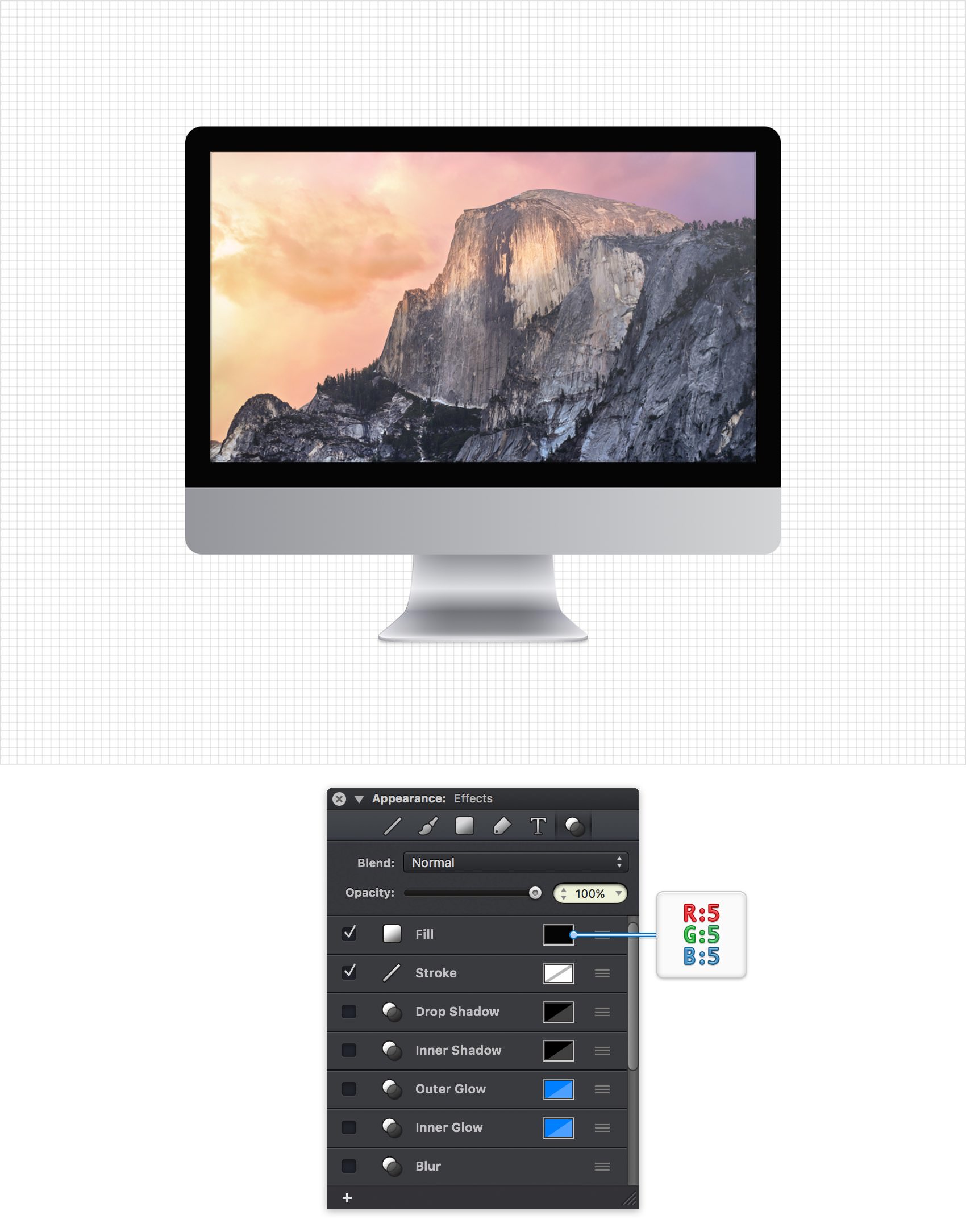
Step 27
Copy this Apple logo | | and get back to your document. Pick the Text Tool (T), click on your canvas and paste the symbol copied a few moments ago. Make sure that it stays selected and focus on the Text pane from the Appearance panel. Don't bother to change the font, but set the size to 21 pt and then click that Convert Text to Outline button.
Make sure that the resulting shapes are selected, go to the Path Tools pane from the Properties panel and click the Make Compound Path button.
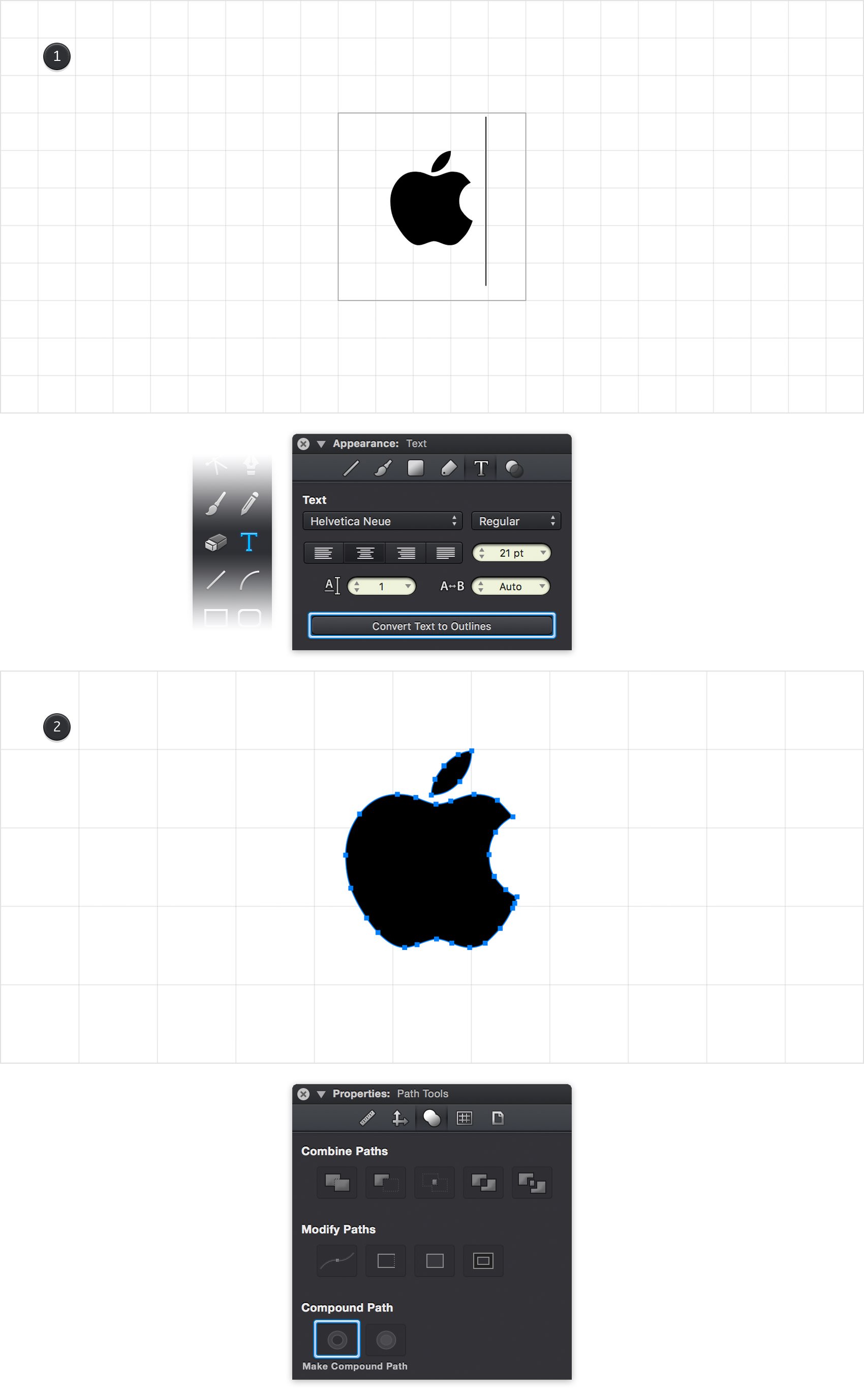
Step 28
Finally, place your Apple logo as shown below.

Finished Design
Congratulations, you've finished the tutorial!
Hope you've enjoyed learning some of the techniques and processes presented in these steps. As always, feel free to adjust the final design and make it your own.
